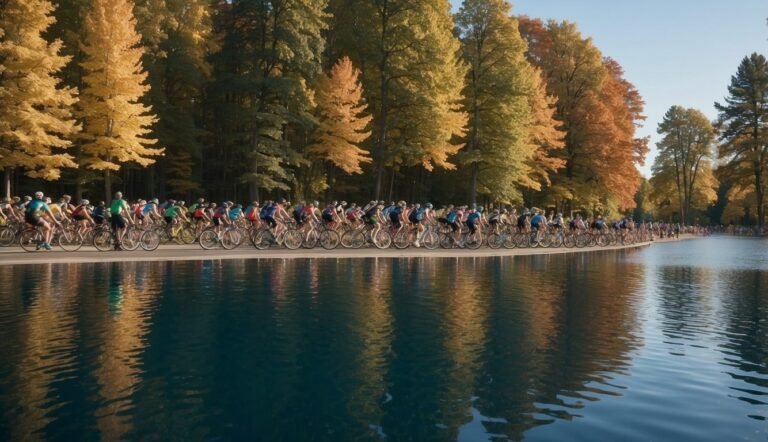📦 FREE Shipping
How Long is the Swim in a Triathlon 2024? The First Leg!

Triathlons are exhilarating multisport events that combine swimming, cycling, and running in one challenging competition. You might wonder: How Long is the Swim in a Triathlon?
As I delve into the world of triathlon, I find the swim leg particularly intriguing—it’s the first discipline and sets the tone for the rest of the race. The distance of the swim varies depending on the triathlon’s overall length; a Sprint triathlon swim is usually 750 meters or 0.47 miles, while an Olympic version features a 1.5-kilometer or 0.93-mile swim.

Interestingly, more accessible triathlon categories exist, such as the Super Sprint, where the swim distance is shorter, around 400 meters, to welcome beginners into the sport. As one progresses to longer distances like the Half-Ironman or Ironman triathlons, the swim legs extend to 1.9 kilometers (1.2 miles) and 3.8 kilometers (2.4 miles), respectively. These varying distances allow both new enthusiasts and seasoned athletes to find a challenge tailored to their fitness levels and goals.
The importance of the swim cannot be overstated—it’s not just about endurance but also technique and pacing, which are crucial for conserving energy for the bike and run segments that follow. Regardless of the triathlon distance, the swim is a thrilling start to the multi-stage adventure that lies ahead in each race.
Understanding Triathlon Distances
I’m excited to share the various swimming distances you’ll encounter in triathlon events, from the fast-paced sprints to the endurance-testing Ironman races. These distances are a critical component of each race, setting the stage for the bike and run segments that follow.
Sprint and Super Sprint Triathlon
Sprint Distance Triathlons: Usually, the swim is about 750 meters (0.47 miles). These races are fantastic for beginners.
- Super Sprint Triathlon: An even shorter distance, the swim is typically around 400 meters (0.25 miles), perfect for my first-timers out there looking to get a taste of the triathlon world.
Olympic Distance Triathlon
In an Olympic Triathlon, I’m looking at a 1.5 kilometers (0.93 miles) swim. This is also known as the “standard” distance and it’s a step up for those who have mastered the sprint distance.
Half Ironman Triathlon
The Half Ironman Triathlon – also known as 70.3 – has a swim distance set at 1.9 kilometers (1.2 miles). It’s a significant increase that tests my endurance and prepares me for the granddaddy of all triathlons.

Full Ironman Triathlon
The ultimate test in a Full Ironman Triathlon is a 3.8 kilometers (2.4 miles) swim. It’s the first challenge in the longest distance triathlon event and a bucket list item for serious triathletes like me.
The Swim in Triathlon
The swim is the adrenaline-pumping start to every triathlon, where athletes clash against the elements whether in open water or a pool. Understanding the various swim portions and techniques is vital for my success in the sport.
Open Water vs Pool Swimming
Swimming in a triathlon usually takes place in open waters such as oceans, lakes, or rivers, but occasionally the swim could be in a pool—each has its unique challenges. In open water, I contend with elements like currents and waves, requiring me to be adept at navigation and handling the unpredictability. A wetsuit can be a great ally here, providing not just warmth but also buoyancy. Pool swims, on the other hand, offer a controlled environment, where I can focus on consistent lap times without environmental stressors.
Swim Distances by Triathlon Type
Swim distances in triathlon vary drastically based on the event. Here’s a quick breakdown:
- Super Sprint Triathlon: Typically a 300m swim, perfect for beginners like me starting our triathlon journey.
- Sprint Triathlon: A 750m swim that tests my speed and endurance without overextending myself.
- Olympic Distance: The swim leg stretches to 1.5km here, and as an aspiring triathlete, I view this as a respectable mid-range challenge.
- Ironman Triathlon: This is the ultimate test of my swimming mettle with a whopping 3.8km (2.4 miles) swim portion.
Swim Techniques and Training
Mastering efficient techniques is crucial for a strong swim leg. I’ve learned to hone my freestyle stroke for maximum efficiency and speed while conserving energy. Training for the swim also involves interval workouts, endurance sessions, and practicing sighting—these help me navigate the course when landmarks are my sole guides. Regularly hitting the pool or open waters, I build not just physical strength but mental fortitude, preparing for the unpredictable nature of race day.

Preparing for the Triathlon Swim
I know how crucial preparation is for the triathlon swim, and with the right training plan, gear, and pacing strategy, I’m setting myself up for success. It’s not just about sheer endurance; it’s about smart preparation and making every stroke count.
Training Plans and Schedules
To begin, I create a detailed training plan that caters to both my fitness level and the triathlon category I’m aiming for. Here’s a basic weekly schedule I follow:
- Monday: Rest or light activity
- Tuesday: Swim – focus on form and technique
- Wednesday: Cycling – to build endurance
- Thursday: Swim – interval training for speed
- Friday: Running – steady-state cardio
- Saturday: Swim – long-distance sessions
- Sunday: Brick workout – cycling and running back-to-back to get used to transitions
I touch base with a coach regularly to ensure I’m progressing well and to adjust my plan as needed.
Gear and Equipment
The right equipment can make a big difference. Here’s a checklist of the gear I make sure to have:
- Swimsuit: Comfortable and reduces drag.
- Wetsuit: For open water swims, crucial for buoyancy and warmth.
- Goggles: Clear vision underwater is a must.
- Swim cap: Keeps my hair out of the way and reduces resistance.
- Tri suit: Ideal for quick transitions between swim, bike, and run segments.
Pacing and Endurance
Learning to pace myself effectively during the swim is vital. Starting too fast can lead to early fatigue, so I practice pacing in my workouts. I build endurance by gradually increasing my swim distance over time, focusing on maintaining a consistent speed that I can sustain throughout the swimming portion. I always listen to my body to avoid overtraining, as recovery is just as important for improving my overall performance.
Expert Insights and Stories
I’ve always been in awe of the incredible feats that triathlon athletes accomplish, particularly in the swim leg of the race. The stories of record-breaking athletes, best practices from the pros, and the psychology behind endurance sports never cease to amaze and inspire me.
Record-Breaking Athletes
In the world of triathlons, Kristian Blummenfelt stands out as a formidable figure. When we talk about real endurance, it’s athletes like him who redefine what’s humanly possible. Blummenfelt currently holds the world record for the Ironman 70.3 with a time that makes my head spin—just over 3 hours and 29 minutes!
Notable Swim Record:
| Event | Distance | Athlete | Record Swim Time |
|---|---|---|---|
| Olympic Distance | 1.5km | Kristian Blummenfelt | Approximately 18 minutes |
Best Practices from Pro Triathletes
The tips and techniques from the champions are invaluable. I’ve noted that proper nutrition and pacing are as crucial to the swim as the technique itself. Pro triathletes emphasize mastering the efficiency of each stroke and strategically conserving energy for the bike and run to follow.
Key Techniques:
- Long, smooth strokes to conserve energy
- Steady, controlled breathing to maintain rhythm
Psychology of Endurance Sports
The mental aspect, often an untold story, is as integral as the physical training. My discussions with elite triathletes reveal that mentally preparing for the endurance challenge is critical. They engage in visualization and goal-setting, which prove essential to conquering the swim leg, especially in daunting distances such as the full marathon of an Ironman triathlon.
Crucial Psychological Aspects:
- Visualization of the racecourse
- Setting realistic goals for each leg
I’ve gleaned so much from these narratives and practices. They demonstrate the epic blend of physical prowess, elite-level strategy, and mental fortitude required to excel, particularly in the swim—an exhilarating kickoff to the multi-stage challenge that is a triathlon.
Frequently Asked Questions about How Long is the Swim in a Triathlon
Triathlon swims can be exhilarating! I’m ready to dive into the specifics of swim distances for various triathlon events. Whether you’re just starting or targeting the iconic Ironman, knowing these distances is crucial for your training and race day success.
What are the swim distances for various triathlon levels, from beginner to Ironman?
In a Sprint triathlon, the swim is typically 750 meters. For an Olympic triathlon, it’s 1.5 kilometers. A Half Ironman features a 1.9-kilometer swim, and the full Ironman boasts a 3.8-kilometer swim.
Can you break down the swim, bike, and run distances in a standard Olympic triathlon?
Sure! The Olympic triathlon consists of a 1.5-kilometer swim, followed by a 40-kilometer bike ride, and wraps up with a 10-kilometer run.
How does the swim distance in a Sprint triathlon compare to longer distances?
The Sprint triathlon swim is 750 meters, making it approachable for beginners. This distance is half of the Olympic swim and notably shorter than the distances in Half Ironman and Ironman races.
What’s the typical swim distance for a first-time triathlete?
Most first-timers opt for a Sprint triathlon, which has a swim distance of 750 meters. It’s a manageable challenge for newcomers to the sport.
During an Ironman triathlon, how many miles does the swim portion cover?
The swim portion of an Ironman covers 2.4 miles, which is the equivalent of 3.8 kilometers.
For an Olympic triathlon, how many laps in the pool would the swim be equivalent to?
This depends on the pool size. In a 50-meter pool, an Olympic triathlon’s 1.5-kilometer swim would be 30 laps, whereas in a 25-yard pool, it would be around 66 laps.
Is your question “How Long is the Swim in a Triathlon?” answered? Leave me a comment and make sure to also check out Triathlon Equipment and What is an Ironman Run.





